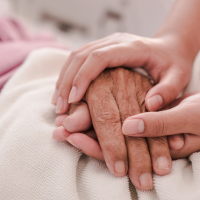Loss of Appetite When Dying Explained

Why do the dying lose their appetite?
The digestive process can be fairly taxing on the body. The process of breaking down foods or even processing nutrients require a level of energy that the dying person may just not have. One way even the healthy may have experienced this is growing nauseous or even vomiting following an intense physical workout. During an exhaustive workout, the body reallocates resources such as blood and energy to the muscle groups and organs that require it most. This leaves the digestive system with limited energy, thus frequently inducing nausea or vomiting because it is unable to process the food at the moment. A dying person’s body is reallocating similarly limited energy supplies to keep the essential systems of the body working. Because of this, their bodies lack the strength to digest food, thus making the presence of that food or fluid in their systems uncomfortable or even intolerable.
Do people ultimately die of starvation?
It may seem like a loved one towards the end of life who has not eaten perhaps in days or even over a week is essentially dying of starvation. This is not the case. The person will eventually pass away due to their illness. It is important to remember that it's not they have simply given up on life and chosen not to eat or drink, but they simply can’t and often do not want to.
Isn’t it painful not to eat or drink while dying?
Most of us can hardly imagine going more than a day without eating. The dying, however, typically do not experience discomfort associated with not eating or even dehydration besides possibly a dry mouth. Once dehydrated to a certain degree, the brain frequently releases endorphins that block many pain receptors — a kind of built-in pain-killer system. These endorphins can even induce a euphoric feeling. Artificial nutrition, on the other hand, can induce a form of false hope for the body, allowing it to continue to fight to stay alive — a painful, hopeless fight that typically only prolongs the dying process.
If you would like more information about hospice or palliative care in the Tulsa area, you’re invited to learn more about and reach out to the caring professionals at Cura HPC.





